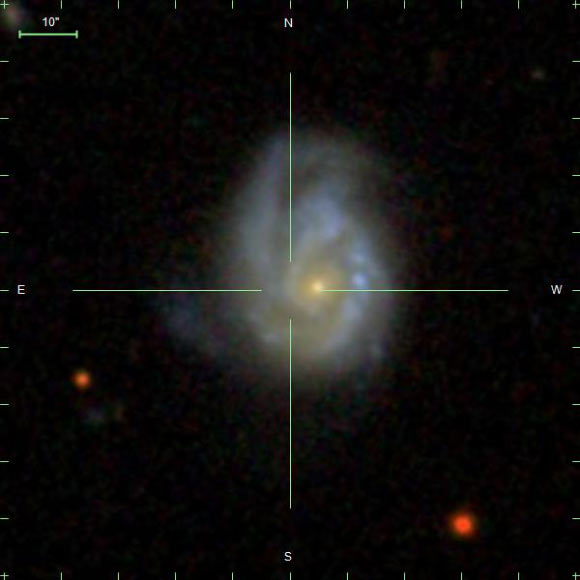At a distance of 420 million light-years, the recently-discovered SN 2017egm is the nearest Type I superluminous supernova to date, and the first near the center of a massive spiral galaxy. Its discovery challenges current ideas of how and where such extreme supernovae occur.

SDSS DR14 image of the massive spiral galaxy NGC 3191; the cross-hairs mark the position of SN 2017egm. Image credit: SDSS.
Supernovae are some of the most energetic events in the Universe.
When a massive star runs out of fuel, it can collapse onto itself and create a spectacular explosion that briefly outshines an entire galaxy, dispersing vital elements into space.
Superluminous supernovae are up to 100 times brighter than a typical supernova, but astronomers still don’t know exactly what kinds of stars give rise to their luminosity or what physical processes are involved.
SN 2017egm, also known as Gaia17biu, was discovered by ESA’s Gaia satellite on May 23, 2017, in the spiral galaxy NGC 3191.
The host galaxy lies 420 million light-years away from Earth, making SN 2017egm about three times closer than any other superluminous supernova previously seen.
SN 2017egm was initially classified as a luminous type II supernova.
The classification was later revised by Kavli Institute astronomer Dr. Subo Dong and co-authors, when the follow-up observations with the Nordic Optical Telescope revealed unusual features.
The researchers realized that NGC 3191 was very surprising, as virtually all known superluminous supernovae have been found in dwarf galaxies that are much smaller than spiral galaxies like the Milky Way.
Building on this discovery, a team led by Dr. Matt Nicholl from the Harvard-Smithsonian Center for Astrophysics (CfA) found that the host galaxy has a high concentration of elements heavier than hydrogen and helium, which astronomers call ‘metals.’
This is the first clear evidence for a metal-rich birthplace for a superluminous supernova.
The dwarf galaxies that usually host superluminous supernovae are known to have a low metal content, which was thought to be an essential ingredient for making these explosions.
“Superluminous supernovae were already the rock stars of the supernova world. We now know that some of them like heavy metal, so to speak, and explode in galaxies like our own Milky Way,” Dr. Nicholl said.
“If one of these went off in our own Galaxy, it would be much brighter than any supernova in recorded human history and would be as bright as the full Moon,” added team member Professor Edo Berger, also of the CfA.
“However, they’re so rare that we probably have to wait several million years to see one.”
The team also found more clues about the nature of SN 2017egm.
“Our study supports the idea that a rapidly spinning, highly magnetized neutron star, called a magnetar, is likely the engine that drives the incredible amount of light generated by these supernovae,” the astronomers said.
“While the brightness of SN 2017egm and the properties of the magnetar that powers it overlap with those of other superluminous supernovae, the amount of mass ejected by SN 2017egm may be lower than the average event.”
“This difference may indicate that the massive star that led to SN 2017egm lost more mass than most superluminous supernova progenitors before exploding. The spin rate of the magnetar may also be slower than average.”
These results show that the amount of metals has at most only a small effect on the properties of a superluminous supernova and the engine driving it.
However, the metal-rich variety occurs at only about 10% of the rate of the metal-poor ones.
The team’s findings will be published in the Astrophysical Journal Letters. The article is also publicly available at arXiv.org.
_____
Matt Nicholl et al. 2017. The superluminous supernova SN 2017egm in the nearby galaxy NGC 3191: a metal-rich environment can support a typical SLSN evolution. ApJL, accepted for publication; arXiv: 1706.08517







